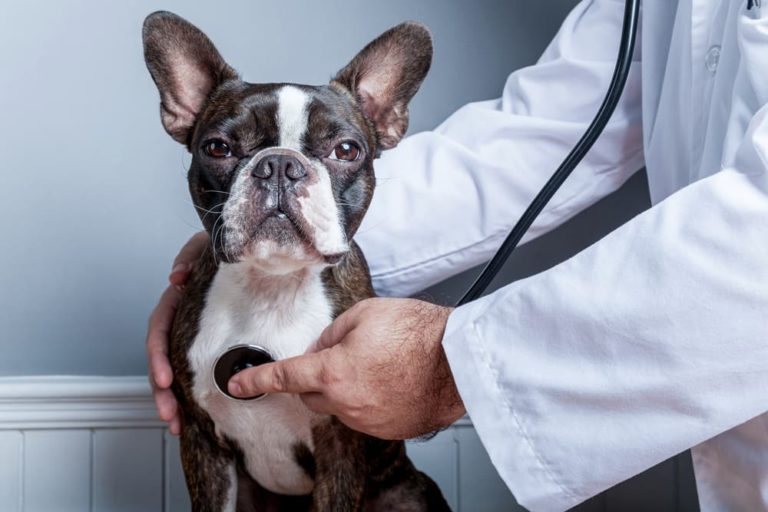Where Is a Dog’s Heart? Understanding Canine Heart Anatomy

Lay your hands on your dog’s chest, in the space just behind their elbows. Right there, you will feel it — the thump, thump of your dog’s heart, one of the most critical and hardest-working organs in their body.
A healthy heart allows a dog to run, play, and do everything else a dog does. So, understanding canine heart anatomy is essential to ensure your dog stays in good physical condition.
Where Is a Dog’s Heart Located in the Body?
A dog’s heart sits roughly in the middle of the chest between the lungs in an upright position. The position of a dog’s heart is roughly the same for most dogs, but there is some variation between breeds, says Dr. Joanne Harris, a veterinary cardiology specialist at HeartVets in Exeter, U.K.
“If you have a very barrel-chested breed like a French Bulldog, for example, or an English Bulldog, their heart will sit in a slightly different position because their chest is very round,” says Dr. Harris. “Whereas if you have a very narrow deep-chested breed like a Whippet, Doberman, or Boxer, then everything is more upright.”
Knowing the location of a dog heart might be helpful in the rare situation when you might need to give a dog CPR.
“You can do external cardiac massage in dogs just as you can on people,” says Dr. Harris. “It’s easier in those narrow-chested breeds because you can go across the heart rather than having to put just downward pressure on it.”
However, Dr. Harris says she doesn’t actually recommend anyone without proper training to perform CPR on dogs. For one, she says that heart attacks are uncommon in dogs since they don’t get coronary artery disease as people do, so the situations in which CPR is required are rare. Secondly, she says it is easy to misjudge a situation where a dog needs CPR.
“I would say fainting is by far the most common reason that dogs may acutely collapse and not seem to have a heartbeat, and I think in that moment of panic, some dogs owners may struggle to feel a heartbeat,” says Dr. Harris, “but we wouldn’t recommend in that situation that they attempt any kind of CPR unless they have some training in this.”
Dog Heart Anatomy: A Closer Look

The cardiovascular system of a dog consists of a four-chambered, oval-shaped heart and a network of blood vessels, including veins, arteries, and capillaries. The right side of a dog’s heart pumps blood to the lungs, while the left side pumps blood to the rest of the body.
The size of a canine heart will vary depending on the dog’s size. “Obviously, a Chihuahua is going to have a smaller heart than a Great Dane,” says Dr. Gabrielle Fadl, Director of Primary Care at Bond Vet. “However, the size of the heart relative to the size of the dog is fairly consistent between breeds.”
All dogs have a circulating blood volume of about 80 milliliters per kilogram in body weight — but the amount of blood each dog circulates will, once again, differ depending on a dog’s size. “A Chihuahua may have around 400ml of blood, but a Great Dane would have around 6.5 liters,” says Dr. Harris.
What’s a normal heart rate for dogs? It is commonly believed that a dog’s body weight will affect heart rate, with smaller dogs having a faster heartbeat than younger dogs — but research has shown this may be untrue. For most dogs, the average heart rate is about 120 beats per minute (bpm), although young dogs under 12 months can have a slightly higher rate. Additionally, excited or nervous dogs may have a higher heart rate than calm dogs, experts say.
Dog Heart vs. Human Heart
Dogs and humans might be physically different in many ways, but the anatomy of our hearts is comparable.
“A dog heart and a human heart are actually very similar, having four chambers (left and right atria, and left and right ventricles) and a similar method of functioning,” says Dr. Fadl. “Some of the larger blood vessels coming directly from the heart even share the same names, including the aorta (the vessel that carries oxygenated blood from the heart to the rest of the body) and the vena cava (the large vessel that returns blood to the heart).”
But when it comes to heart conditions, there are some key differences between humans and dogs, says Dr. Fadl. “Humans commonly get atherosclerosis or plaque buildup in their arteries, which can lead to a blockage and a heart attack,” says Dr. Fadl. “Dogs don’t really tend to have this type of issue. Instead, more common conditions for them include a leaky heart valve (usually with age, especially in small dogs) or problems with the heart muscles (more common in larger breeds).”
All heart murmurs in puppies should be monitored. Quiet heart murmurs in puppies are usually benign, but if a quiet murmur gets louder or does not go away by 6 months of age, then the puppy likely has a congenital heart abnormality. Loud heart murmurs are almost always associated with heart conditions in puppies. “So, if your puppy is diagnosed with a moderate or loud heart murmur at a young age, then it is best to seek cardiologist advice and find out if the puppy needs an echocardiogram,” says Dr. Harris.
Other common heart issues dogs may face include congestive heart failure and heartworm disease in areas where it is endemic.
Heart Health for Dogs: What to Know

You can do many things to help keep your dog — and their heart — as healthy as possible.
“Maintaining a healthy weight is good to prevent excess strain on the heart, lungs, and joints,” says Dr. Fadl. “Take your dog to recommended checkups with your veterinarian, even if they seem healthy. It’s not unusual for vets to discover subtle signs of disease (like the abnormal heart sounds or rhythms mentioned above) in the early stages before symptoms develop. Earlier diagnosis often means treatment is more effective and less costly. Also, keep your dog on heartworm prevention as recommended, to protect their heart from these parasites.”
According to Dr. Harris, a lot of heart disease in dogs has a genetic component. For example, little dogs like Cavalier King Charles Spaniels, Chihuahuas, Poodles, and Dachshunds have a higher likelihood of developing disease of the heart valves. If you want to buy a breed that is prone to heart disease, Dr. Harris says “…it’s best to do your research first and find out what screening programs are in place and buy puppies from breeders that are breeding dogs that have been screened and are listed as being clear of that disease.”
Dr. Harris also advises taking your dog to a cardiology specialist if a veterinarian detects a heart murmur or irregular heart rhythm. And, of course, seek medical advice if your dog faints or collapses or displays symptoms like shallow breathing or unusual tiredness after exercise.
Your quick action may save your dog’s life — and ensure that their heart keeps working in the healthiest way possible.









